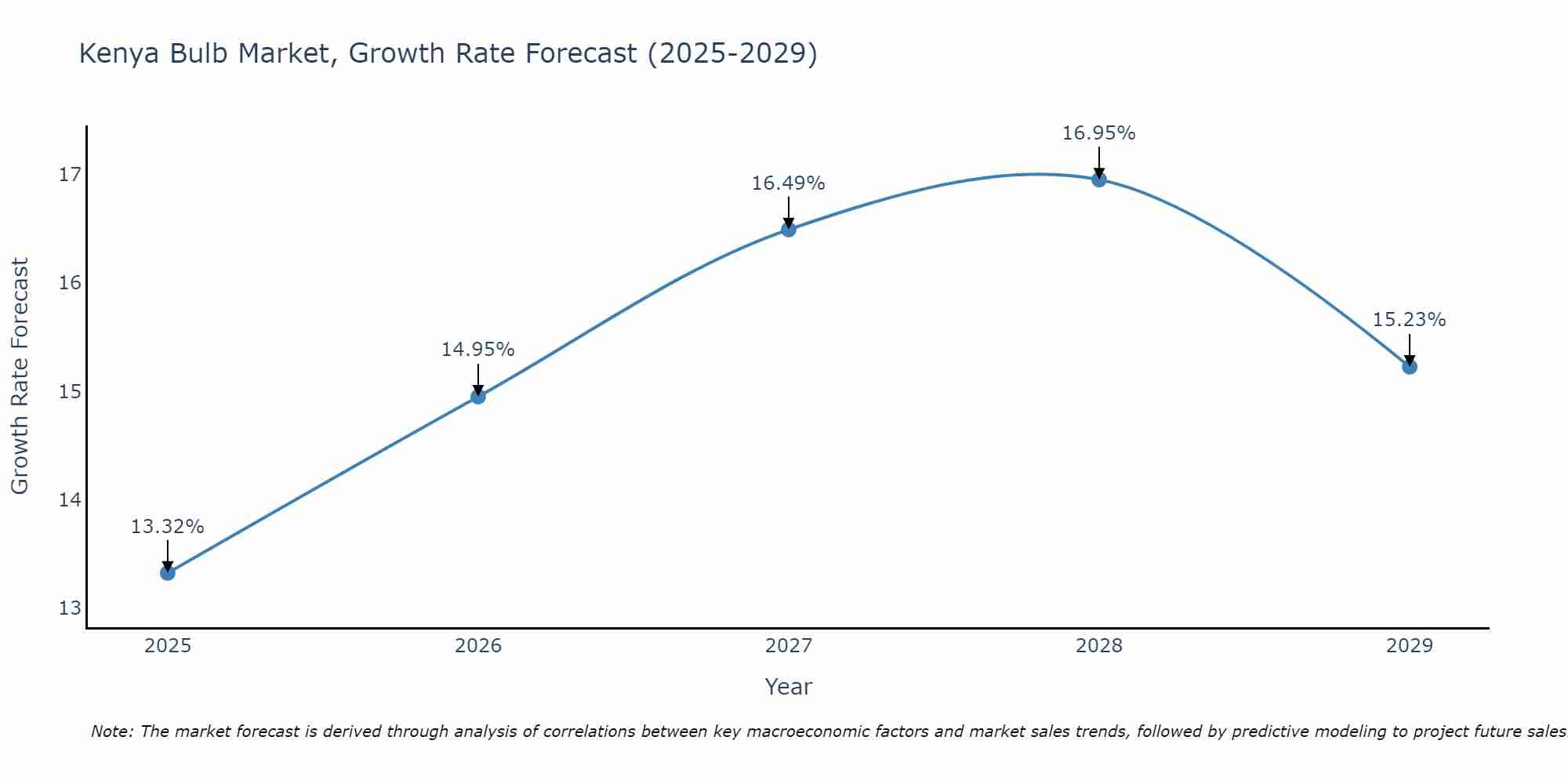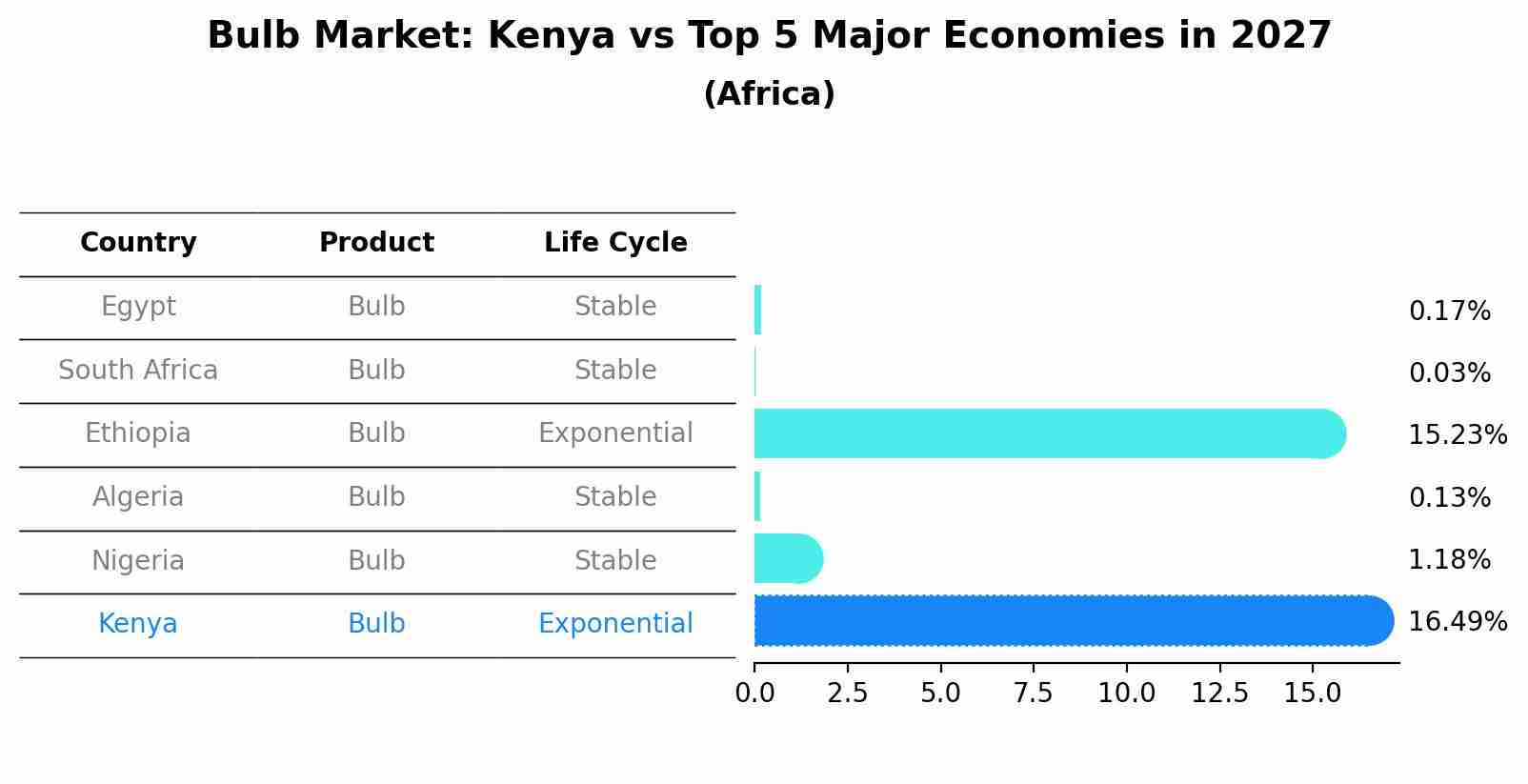Kenya Bulb Market Outlook | Industry, Size, Revenue, Trends, Share, Forecast, Analysis, COVID-19 IMPACT, Growth, Companies & Value
| Product Code: ETC258770 | Publication Date: Aug 2022 | Updated Date: Aug 2025 | Product Type: Market Research Report | |
| Publisher: 6Wresearch | No. of Pages: 75 | No. of Figures: 35 | No. of Tables: 20 | |
Kenya Bulb Market Size Growth Rate
The Kenya Bulb Market is projected to witness mixed growth rate patterns during 2025 to 2029. The growth rate begins at 13.32% in 2025, climbs to a high of 16.95% in 2028, and moderates to 15.23% by 2029.

Bulb Market: Kenya vs Top 5 Major Economies in 2027 (Africa)
By 2027, Kenya's Bulb market is forecasted to achieve a exponential growth rate of 16.49%, with Egypt leading the Africa region, followed by South Africa, Ethiopia, Algeria and Nigeria.

Kenya Bulb Market Overview
Kenya bulb market is expanding, driven by the need for energy-efficient lighting solutions. Government initiatives include promoting the use of LED and other energy-saving bulbs through subsidies and awareness campaigns. Regulatory measures to phase out incandescent bulbs are also contributing to the growth of this market.
Drivers of the market
The bulb market in Kenya is witnessing growth due to the country`s efforts to transition to energy-efficient lighting solutions such as LED bulbs. Government initiatives promoting energy conservation, rising electricity costs, and increasing consumer awareness of LED bulbs` benefits drive market expansion.
Challenges of the market
The bulb market in Kenya is constrained by competition from alternative lighting technologies and high costs. Traditional bulbs face competition from energy-efficient LED and CFL bulbs, which offer longer lifespan and lower energy consumption. Additionally, fluctuations in raw material prices and the need for continuous innovation to improve efficiency and performance impact market dynamics.
Government Policy of the market
In alignment with efforts to promote energy efficiency and transition to low-carbon technologies, the Kenya government has implemented policies to regulate the bulb market. These policies include phasing out inefficient incandescent bulbs, promoting the use of energy-efficient LED and CFL bulbs through subsidies and public awareness campaigns, and setting minimum energy performance standards for lighting products to reduce electricity consumption and greenhouse gas emissions.
Key Highlights of the Report:
- Kenya Bulb Market Outlook
- Market Size of Kenya Bulb Market, 2021
- Forecast of Kenya Bulb Market, 2028
- Historical Data and Forecast of Kenya Bulb Revenues & Volume for the Period 2018 - 2028
- Kenya Bulb Market Trend Evolution
- Kenya Bulb Market Drivers and Challenges
- Kenya Bulb Price Trends
- Kenya Bulb Porter's Five Forces
- Kenya Bulb Industry Life Cycle
- Historical Data and Forecast of Kenya Bulb Market Revenues & Volume By Type for the Period 2018 - 2028
- Historical Data and Forecast of Kenya Bulb Market Revenues & Volume By Incandescent Bulbs for the Period 2018 - 2028
- Historical Data and Forecast of Kenya Bulb Market Revenues & Volume By Fluorescent Bulbs for the Period 2018 - 2028
- Historical Data and Forecast of Kenya Bulb Market Revenues & Volume By CFLs for the Period 2018 - 2028
- Historical Data and Forecast of Kenya Bulb Market Revenues & Volume By Halogens for the Period 2018 - 2028
- Historical Data and Forecast of Kenya Bulb Market Revenues & Volume By LEDs for the Period 2018 - 2028
- Historical Data and Forecast of Kenya Bulb Market Revenues & Volume By Application for the Period 2018 - 2028
- Historical Data and Forecast of Kenya Bulb Market Revenues & Volume By Lamps & Light Bulbs for the Period 2018 - 2028
- Historical Data and Forecast of Kenya Bulb Market Revenues & Volume By Operation Theatre (OT Instruments) for the Period 2018 - 2028
- Historical Data and Forecast of Kenya Bulb Market Revenues & Volume By Torchlights and Flashlights for the Period 2018 - 2028
- Historical Data and Forecast of Kenya Bulb Market Revenues & Volume By Automobile Headlights for the Period 2018 - 2028
- Historical Data and Forecast of Kenya Bulb Market Revenues & Volume By Mining Headgears for the Period 2018 - 2028
- Historical Data and Forecast of Kenya Bulb Market Revenues & Volume By Others for the Period 2018 - 2028
- Kenya Bulb Import Export Trade Statistics
- Market Opportunity Assessment By Type
- Market Opportunity Assessment By Application
- Kenya Bulb Top Companies Market Share
- Kenya Bulb Competitive Benchmarking By Technical and Operational Parameters
- Kenya Bulb Company Profiles
- Kenya Bulb Key Strategic Recommendations
Frequently Asked Questions About the Market Study (FAQs):
1 Executive Summary |
2 Introduction |
2.1 Key Highlights of the Report |
2.2 Report Description |
2.3 Market Scope & Segmentation |
2.4 Research Methodology |
2.5 Assumptions |
3 Kenya Bulb Market Overview |
3.1 Kenya Country Macro Economic Indicators |
3.2 Kenya Bulb Market Revenues & Volume, 2021 & 2028F |
3.3 Kenya Bulb Market - Industry Life Cycle |
3.4 Kenya Bulb Market - Porter's Five Forces |
3.5 Kenya Bulb Market Revenues & Volume Share, By Type, 2021 & 2028F |
3.6 Kenya Bulb Market Revenues & Volume Share, By Application, 2021 & 2028F |
4 Kenya Bulb Market Dynamics |
4.1 Impact Analysis |
4.2 Market Drivers |
4.2.1 Increasing urbanization and infrastructure development in Kenya leading to higher demand for lighting solutions. |
4.2.2 Government initiatives promoting energy-efficient lighting solutions to reduce electricity consumption. |
4.2.3 Growth in the construction sector driving the demand for bulbs in residential, commercial, and industrial buildings. |
4.3 Market Restraints |
4.3.1 Volatility in raw material prices impacting the production cost of bulbs. |
4.3.2 Intense competition from LED lighting solutions affecting the market share of traditional bulbs. |
4.3.3 Economic instability and fluctuations in currency exchange rates affecting consumer purchasing power. |
5 Kenya Bulb Market Trends |
6 Kenya Bulb Market, By Types |
6.1 Kenya Bulb Market, By Type |
6.1.1 Overview and Analysis |
6.1.2 Kenya Bulb Market Revenues & Volume, By Type, 2018 - 2028F |
6.1.3 Kenya Bulb Market Revenues & Volume, By Incandescent Bulbs, 2018 - 2028F |
6.1.4 Kenya Bulb Market Revenues & Volume, By Fluorescent Bulbs, 2018 - 2028F |
6.1.5 Kenya Bulb Market Revenues & Volume, By CFLs, 2018 - 2028F |
6.1.6 Kenya Bulb Market Revenues & Volume, By Halogens, 2018 - 2028F |
6.1.7 Kenya Bulb Market Revenues & Volume, By LEDs, 2018 - 2028F |
6.2 Kenya Bulb Market, By Application |
6.2.1 Overview and Analysis |
6.2.2 Kenya Bulb Market Revenues & Volume, By Lamps & Light Bulbs, 2018 - 2028F |
6.2.3 Kenya Bulb Market Revenues & Volume, By Operation Theatre (OT Instruments), 2018 - 2028F |
6.2.4 Kenya Bulb Market Revenues & Volume, By Torchlights and Flashlights, 2018 - 2028F |
6.2.5 Kenya Bulb Market Revenues & Volume, By Automobile Headlights, 2018 - 2028F |
6.2.6 Kenya Bulb Market Revenues & Volume, By Mining Headgears, 2018 - 2028F |
6.2.7 Kenya Bulb Market Revenues & Volume, By Others, 2018 - 2028F |
7 Kenya Bulb Market Import-Export Trade Statistics |
7.1 Kenya Bulb Market Export to Major Countries |
7.2 Kenya Bulb Market Imports from Major Countries |
8 Kenya Bulb Market Key Performance Indicators |
8.1 Average selling price (ASP) of bulbs in the market. |
8.2 Adoption rate of energy-efficient bulbs in Kenya. |
8.3 Number of new construction projects using bulbs as part of their lighting solutions. |
8.4 Consumer sentiment towards traditional bulbs versus LED bulbs. |
8.5 Investment in research and development for innovative bulb technologies in the Kenyan market. |
9 Kenya Bulb Market - Opportunity Assessment |
9.1 Kenya Bulb Market Opportunity Assessment, By Type, 2021 & 2028F |
9.2 Kenya Bulb Market Opportunity Assessment, By Application, 2021 & 2028F |
10 Kenya Bulb Market - Competitive Landscape |
10.1 Kenya Bulb Market Revenue Share, By Companies, 2021 |
10.2 Kenya Bulb Market Competitive Benchmarking, By Operating and Technical Parameters |
11 Company Profiles |
12 Recommendations |
13 Disclaimer |
- Single User License$ 1,995
- Department License$ 2,400
- Site License$ 3,120
- Global License$ 3,795
Search
Related Reports
- Portugal Electronic Document Management Market (2025-2031) | Strategy, Consumer Insights, Analysis, Investment Trends, Opportunities, Growth, Size, Share, Industry, Revenue, Segments, Value, Segmentation, Supply, Forecast, Restraints, Outlook, Competition, Drivers, Trends, Demand, Pricing Analysis, Competitive, Strategic Insights, Companies, Challenges
- France Electronic Document Management Market (2025-2031) | Strategy, Consumer Insights, Analysis, Investment Trends, Opportunities, Growth, Size, Share, Industry, Revenue, Segments, Value, Segmentation, Supply, Forecast, Restraints, Outlook, Competition, Drivers, Trends, Demand, Pricing Analysis, Competitive, Strategic Insights, Companies, Challenges
- Portugal Occupational Health & Safety Services Market (2025-2031) | Strategy, Consumer Insights, Analysis, Investment Trends, Opportunities, Growth, Size, Share, Industry, Revenue, Segments, Value, Segmentation, Supply, Forecast, Restraints, Outlook, Competition, Drivers, Trends, Demand, Pricing Analysis, Competitive, Strategic Insights, Companies, Challenges
- Netherlands Occupational Health and Safety Services Market (2025-2031) | Strategy, Consumer Insights, Analysis, Investment Trends, Opportunities, Growth, Size, Share, Industry, Revenue, Segments, Value, Segmentation, Supply, Forecast, Restraints, Outlook, Competition, Drivers, Trends, Demand, Pricing Analysis, Competitive, Strategic Insights, Companies, Challenges
- Belgium and Luxembourg Facility Management Market (2025-2031) | Strategy, Consumer Insights, Analysis, Investment Trends, Opportunities, Growth, Size, Share, Industry, Revenue, Segments, Value, Segmentation, Supply, Forecast, Restraints, Outlook, Competition, Drivers, Trends, Demand, Pricing Analysis, Competitive, Strategic Insights, Companies, Challenges
- Russia Women Intimate Apparel Market (2025-2031) | Strategy, Consumer Insights, Analysis, Investment Trends, Opportunities, Growth, Size, Share, Industry, Revenue, Segments, Value, Segmentation, Supply, Forecast, Restraints, Outlook, Competition, Drivers, Trends, Demand, Pricing Analysis, Competitive, Strategic Insights, Companies, Challenges
- Africa Chocolate Market (2025-2031) | Size, Share, Trends, Growth, Revenue, Analysis, Forecast, industry & Outlook
- Global Hydroxychloroquine And Chloroquine Market (2025-2031) | Industry, Trends, Size, Outlook, Growth, Value, Companies, Revenue, Analysis, Share, Forecast
- Saudi Arabia Plant Maintenance Market (2025-2031) | Industry, Size, Growth, Revenue, Value, Companies, Forecast, Analysis, Share & Trends
- Taiwan Electric Truck Market (2025-2031) | Outlook, Industry, Revenue, Size, Forecast, Growth, Analysis, Share, Companies, Value & Trends
Industry Events and Analyst Meet
Our Clients
Whitepaper
- Middle East & Africa Commercial Security Market Click here to view more.
- Middle East & Africa Fire Safety Systems & Equipment Market Click here to view more.
- GCC Drone Market Click here to view more.
- Middle East Lighting Fixture Market Click here to view more.
- GCC Physical & Perimeter Security Market Click here to view more.
6WResearch In News
- Doha a strategic location for EV manufacturing hub: IPA Qatar
- Demand for luxury TVs surging in the GCC, says Samsung
- Empowering Growth: The Thriving Journey of Bangladesh’s Cable Industry
- Demand for luxury TVs surging in the GCC, says Samsung
- Video call with a traditional healer? Once unthinkable, it’s now common in South Africa
- Intelligent Buildings To Smooth GCC’s Path To Net Zero













